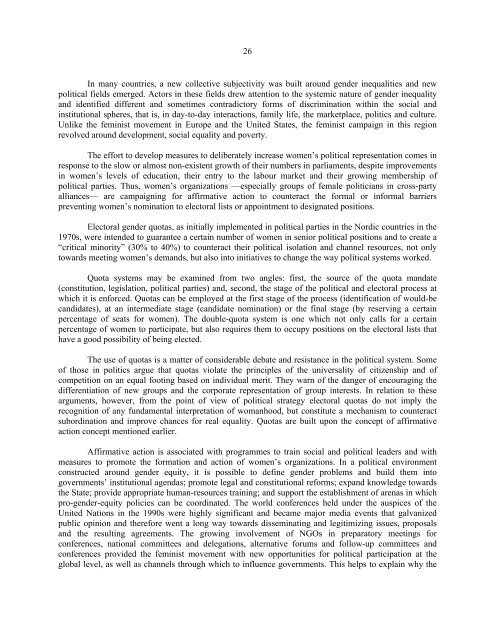Women in Latin America and the Caribbean - Cepal
Women in Latin America and the Caribbean - Cepal
Women in Latin America and the Caribbean - Cepal
Create successful ePaper yourself
Turn your PDF publications into a flip-book with our unique Google optimized e-Paper software.
26<br />
In many countries, a new collective subjectivity was built around gender <strong>in</strong>equalities <strong>and</strong> new<br />
political fields emerged. Actors <strong>in</strong> <strong>the</strong>se fields drew attention to <strong>the</strong> systemic nature of gender <strong>in</strong>equality<br />
<strong>and</strong> identified different <strong>and</strong> sometimes contradictory forms of discrim<strong>in</strong>ation with<strong>in</strong> <strong>the</strong> social <strong>and</strong><br />
<strong>in</strong>stitutional spheres, that is, <strong>in</strong> day-to-day <strong>in</strong>teractions, family life, <strong>the</strong> marketplace, politics <strong>and</strong> culture.<br />
Unlike <strong>the</strong> fem<strong>in</strong>ist movement <strong>in</strong> Europe <strong>and</strong> <strong>the</strong> United States, <strong>the</strong> fem<strong>in</strong>ist campaign <strong>in</strong> this region<br />
revolved around development, social equality <strong>and</strong> poverty.<br />
The effort to develop measures to deliberately <strong>in</strong>crease women’s political representation comes <strong>in</strong><br />
response to <strong>the</strong> slow or almost non-existent growth of <strong>the</strong>ir numbers <strong>in</strong> parliaments, despite improvements<br />
<strong>in</strong> women’s levels of education, <strong>the</strong>ir entry to <strong>the</strong> labour market <strong>and</strong> <strong>the</strong>ir grow<strong>in</strong>g membership of<br />
political parties. Thus, women’s organizations —especially groups of female politicians <strong>in</strong> cross-party<br />
alliances— are campaign<strong>in</strong>g for affirmative action to counteract <strong>the</strong> formal or <strong>in</strong>formal barriers<br />
prevent<strong>in</strong>g women’s nom<strong>in</strong>ation to electoral lists or appo<strong>in</strong>tment to designated positions.<br />
Electoral gender quotas, as <strong>in</strong>itially implemented <strong>in</strong> political parties <strong>in</strong> <strong>the</strong> Nordic countries <strong>in</strong> <strong>the</strong><br />
1970s, were <strong>in</strong>tended to guarantee a certa<strong>in</strong> number of women <strong>in</strong> senior political positions <strong>and</strong> to create a<br />
“critical m<strong>in</strong>ority” (30% to 40%) to counteract <strong>the</strong>ir political isolation <strong>and</strong> channel resources, not only<br />
towards meet<strong>in</strong>g women’s dem<strong>and</strong>s, but also <strong>in</strong>to <strong>in</strong>itiatives to change <strong>the</strong> way political systems worked.<br />
Quota systems may be exam<strong>in</strong>ed from two angles: first, <strong>the</strong> source of <strong>the</strong> quota m<strong>and</strong>ate<br />
(constitution, legislation, political parties) <strong>and</strong>, second, <strong>the</strong> stage of <strong>the</strong> political <strong>and</strong> electoral process at<br />
which it is enforced. Quotas can be employed at <strong>the</strong> first stage of <strong>the</strong> process (identification of would-be<br />
c<strong>and</strong>idates), at an <strong>in</strong>termediate stage (c<strong>and</strong>idate nom<strong>in</strong>ation) or <strong>the</strong> f<strong>in</strong>al stage (by reserv<strong>in</strong>g a certa<strong>in</strong><br />
percentage of seats for women). The double-quota system is one which not only calls for a certa<strong>in</strong><br />
percentage of women to participate, but also requires <strong>the</strong>m to occupy positions on <strong>the</strong> electoral lists that<br />
have a good possibility of be<strong>in</strong>g elected.<br />
The use of quotas is a matter of considerable debate <strong>and</strong> resistance <strong>in</strong> <strong>the</strong> political system. Some<br />
of those <strong>in</strong> politics argue that quotas violate <strong>the</strong> pr<strong>in</strong>ciples of <strong>the</strong> universality of citizenship <strong>and</strong> of<br />
competition on an equal foot<strong>in</strong>g based on <strong>in</strong>dividual merit. They warn of <strong>the</strong> danger of encourag<strong>in</strong>g <strong>the</strong><br />
differentiation of new groups <strong>and</strong> <strong>the</strong> corporate representation of group <strong>in</strong>terests. In relation to <strong>the</strong>se<br />
arguments, however, from <strong>the</strong> po<strong>in</strong>t of view of political strategy electoral quotas do not imply <strong>the</strong><br />
recognition of any fundamental <strong>in</strong>terpretation of womanhood, but constitute a mechanism to counteract<br />
subord<strong>in</strong>ation <strong>and</strong> improve chances for real equality. Quotas are built upon <strong>the</strong> concept of affirmative<br />
action concept mentioned earlier.<br />
Affirmative action is associated with programmes to tra<strong>in</strong> social <strong>and</strong> political leaders <strong>and</strong> with<br />
measures to promote <strong>the</strong> formation <strong>and</strong> action of women’s organizations. In a political environment<br />
constructed around gender equity, it is possible to def<strong>in</strong>e gender problems <strong>and</strong> build <strong>the</strong>m <strong>in</strong>to<br />
governments’ <strong>in</strong>stitutional agendas; promote legal <strong>and</strong> constitutional reforms; exp<strong>and</strong> knowledge towards<br />
<strong>the</strong> State; provide appropriate human-resources tra<strong>in</strong><strong>in</strong>g; <strong>and</strong> support <strong>the</strong> establishment of arenas <strong>in</strong> which<br />
pro-gender-equity policies can be coord<strong>in</strong>ated. The world conferences held under <strong>the</strong> auspices of <strong>the</strong><br />
United Nations <strong>in</strong> <strong>the</strong> 1990s were highly significant <strong>and</strong> became major media events that galvanized<br />
public op<strong>in</strong>ion <strong>and</strong> <strong>the</strong>refore went a long way towards dissem<strong>in</strong>at<strong>in</strong>g <strong>and</strong> legitimiz<strong>in</strong>g issues, proposals<br />
<strong>and</strong> <strong>the</strong> result<strong>in</strong>g agreements. The grow<strong>in</strong>g <strong>in</strong>volvement of NGOs <strong>in</strong> preparatory meet<strong>in</strong>gs for<br />
conferences, national committees <strong>and</strong> delegations, alternative forums <strong>and</strong> follow-up committees <strong>and</strong><br />
conferences provided <strong>the</strong> fem<strong>in</strong>ist movement with new opportunities for political participation at <strong>the</strong><br />
global level, as well as channels through which to <strong>in</strong>fluence governments. This helps to expla<strong>in</strong> why <strong>the</strong>











